-
A Generation of Men Raised by Women
“We’re a generation of men raised by women. I’m wondering if another woman is really the answer we need.”
This comment, made by the Tyler Durden character in the movie Fight Club, is one of the most memorable lines of that film and has oft been repeated and discussed. It’s sticking power is surely due to the way it resonated with many men–how it so succinctly summed up their life’s experience. Products of divorced parents, single mothers, or fathers who spent more time at work than at home, these men lacked a vital example of manhood growing up. Oftentimes, not only was their dad not around, male mentors in other areas of their life were few and far between as well. They understand well Nathaniel Hawthorne’s lament in The Marble Faun:
“Between man and man there is always an insuperable gulf. They can never quite grasp each other’s hands; and therefore man never derives any intimate help, any heart sustenance, from his brother man, but from women-his mother, his sister, his wife.”
Without male mentors, many men of this generation have felt adrift, unsure of how to deal with an indescribable but acute lack in their lives.
How did we get to the point where it is possible, as Edward Abbey put it, “to proceed from infancy into senility without ever knowing manhood?”
There are three primary social institutions that have historically served to mold young boys into men: family, religion, and education. Yet the masculine influence of these institutions diminished over the last century. Let’s take a closer look at each.
The Family
During the pre-industrial period, a man’s home was also his workplace. For the farmer and the artisan, “bring your kid to work day” was every day. Father and son worked side by side from sunrise to sunset. Fathers taught by example, not only apprenticing their sons into the trade, but subtly imparting lessons on hard work and virtue.

This relationship was disrupted by the Industrial Revolution, as fathers were forced to abandon the land and the workshop for a place on the assembly line. A clear line was drawn between the home and the workplace. Dad left the tenement in the morning and did not return for 10-12 hours at a time. As we’ve discussed previously, the result of this economic shift was that the home became thought of as the women’s sphere, a feminine refuge from the rough and dirty professional and political realm, the “man’s world.” Children spent all their time with mom, who, as the repository of virtue and morality, was expected to turn her boys into little gentlemen.
The ideal (which was always more ideal than reality) of mom at home and dad at work would persist into the 1950s. This is still a romantic standard many would like to return to, ignoring the fact that such a set-up kept dad away from his children for the bulk of the day, depriving them of his mentoring and creating a culture where his parenting role was deemed subordinate to mom’s.
But at least in that situation dad was around. The divorce rate began to climb at the turn of the century and peaked around 1980 when many states legalized no-fault divorces. And the courts, as they still do today, typically favored the mother when issuing custody rights. Whereas boys once didn’t see their fathers while they were away at work, now they only saw dad on weekends or holidays. And of course, many dads voluntarily fled from the responsibility of their children; the percentage of single parent households (84% of which are headed by single mothers) has doubled since 1970.
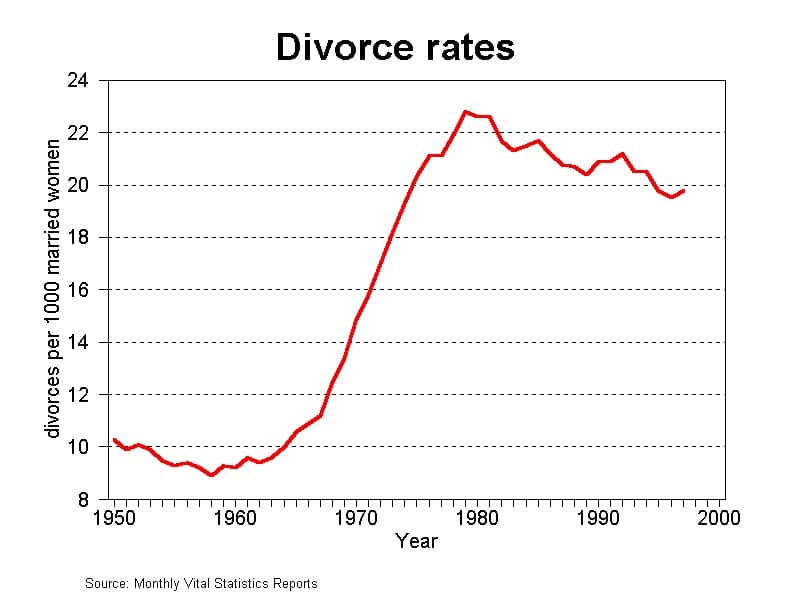

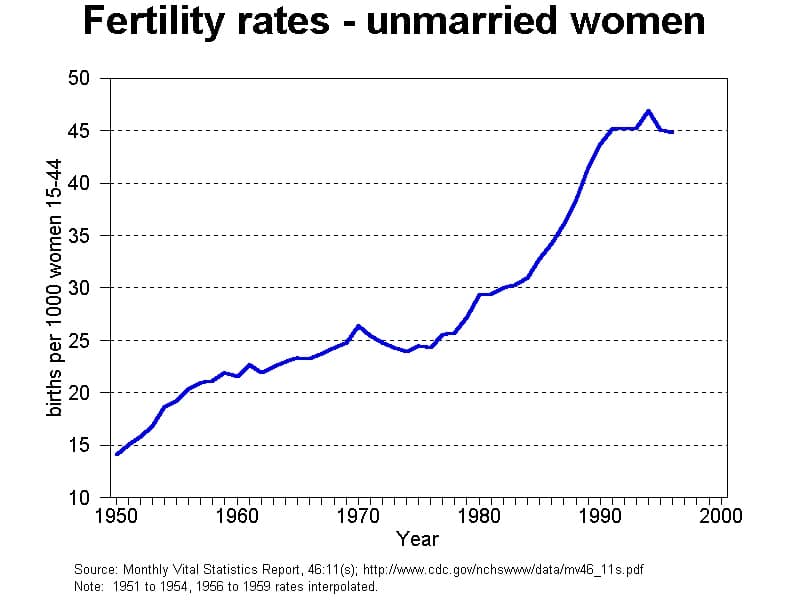
Education
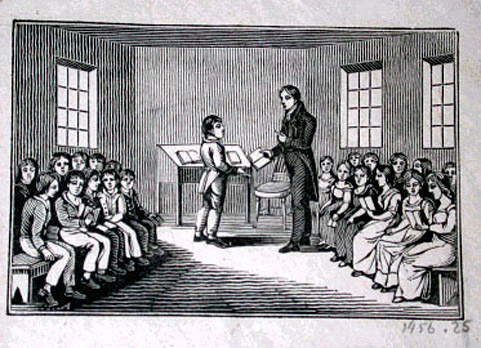 Until the mid-nineteenth century, the vast majority of teachers were men. Teaching was not considered a lifelong career but was rather undertaken by young men during the slow periods on the farm or while studying to become a lawyer or minister. Children were thought to be inherently sinful and therefore prone to unruly behavior; they thus needed a strong male presence to keep them in line. As some Christian denominations became more liberal, the emphasis on children’s sinfulness was replaced by a focus on their need to be gently nurtured into morality, a task believed to be better suited to the fairer sex. At the same time, women were marrying and having children at a later age, allowing them more time to teach before settling down. The result was a complete reversal in the gender make-up of the education profession.
Until the mid-nineteenth century, the vast majority of teachers were men. Teaching was not considered a lifelong career but was rather undertaken by young men during the slow periods on the farm or while studying to become a lawyer or minister. Children were thought to be inherently sinful and therefore prone to unruly behavior; they thus needed a strong male presence to keep them in line. As some Christian denominations became more liberal, the emphasis on children’s sinfulness was replaced by a focus on their need to be gently nurtured into morality, a task believed to be better suited to the fairer sex. At the same time, women were marrying and having children at a later age, allowing them more time to teach before settling down. The result was a complete reversal in the gender make-up of the education profession.
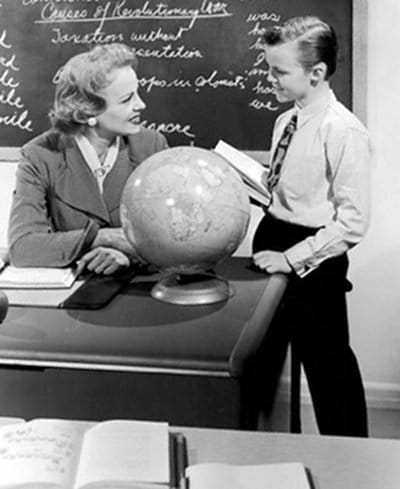
In 1870, women made up 2/3 of teachers, 3/4 in 1900, 4/5 in 1910. As a result, boys were spending a significant portion of their day at school but passing the time without the influence and example of an adult male mentor.
Religion
The third institution that has historically socialized boys into men is religion. And during the past century, that religion for a majority of Americans was Christianity. But if the home had become a thoroughly feminized place, the church was hardly a refuge of masculinity.
Women are more likely to be religious than men-and this holds true across time, place, and faith. This means they have historically been more likely to attend religious services and be active in a congregation. And Christian ministers, whether consciously or not, naturally catered their style and programs to their core audience. The Jesus men encountered in the pews became a wan, gentle soul who glided through Jerusalem patting children’s heads, talking about flowers, and crying.
A push back against the perceived feminization of Christianity began around the turn of the 20th century. Referred to as “Muscular Christianity,” its proponents linked a strong body with a strong faith and sought to inject the gospel with a vigorous virility.
The most visible and popular leader of this movement was the evangelical preacher, Billy Sunday. Sunday had been a professional baseball player before undergoing a conversion to Christianity and deciding to devote himself to spreading the faith. Sundays’ preaching style was charismatic and physical; peppering his sermons with baseball and sports references, he would run back and forth, dive to the stage like he was sliding into a base, and smash chairs to make his point.
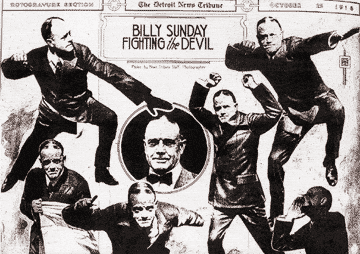
Obviously struck by the difference in Sunday’s preaching versus the typical “effeminate” style of the day, a journalist described Sunday in action:
“He stands up like a man in the pulpit and out of it. He speaks like a man. He works like a man…He is manly with God and with everyone who comes to hear him. No matter how much you disagree with him, he treats you after a manly fashion. He is not an imitation, but a manly man giving all a square deal.”
Sunday presented Jesus as a virile, masculine Savior; he was “the greatest scrapper who ever lived.” Here was a strong Messiah, an artisan with the rough worn hands of a carpenter, a man who angrily chased money changers out of the temple and courageously endured a painful execution. Faith was not for the meek and sedentary. Sunday believed that a Christian man should not be “some sort of dishrag proposition, a wishy-washy, sissified sort of galoot, that lets everybody make a doormat out of him. Let me tell you, the manliest man is the man who will acknowledge Jesus Christ.” “Lord save us from the off-handed, flabby cheeked, brittle boned, weak-kneed, thin-skinned, pliable, plastic, spineless, effeminate, ossified, three karat Christianity,” he prayed.

Operating on the principle that “The manly gospel of Christ should be presented to men by men,” in 1911 Sunday started “The Men and Religion Forward Movement.” Week long revivals just for men were held to great success; male church attendance increased a whopping 800%.
Yet Sunday didn’t solve the problem of getting men into the church-going habit. With the advent of new sources of entertainment, Sunday’s popularity, and that of revivals generally, died out and the gender imbalance in religion remained thoroughly entrenched.
The Current State of Affairs
With fathers missing in action, schools staffed by female teachers, and churches struggling to connect with their male members, many of the current generation might rightly feel they were “raised by women.” Where does that leave them and the future of masculinity?
It’s truly a mixed bag. Many things remain less than ideal, but there is also room for justified optimism.
The gender imbalance for Christian churches has continued to increase. In 1952, the ratio of female to male active church goers was 53/47; now it is 61/39, and the complaint that the culture of Christianity is overly feminized remains. But churches continue to try to attract men into the fold, with attempts that range from the sincere and thoughtful (Men’s Fraternity), to the patently ridiculous (Football Sunday-wear your favorite team’s NFL jersey and do the wave!).
The numbers aren’t too rosy when it comes to education either. In the last 30 years the percentage of male teachers in elementary schools has fallen slightly, from 17% to 14-9% (depending on the source). The number is even lower for pre-k and kindergarten teachers; only 2% are male. While more male teachers can be found in secondary schools, there has been a decline there as well, from 50% in 1980 to around 40% today. With boys falling behind girls in academic performance, some education experts are actively trying to recruit men into the profession.
Despite continuing problems in the familial sphere and its attendant hand-wringing (1 in 3 American kids will grow up in a home where the parents are either divorced, separated, or never married), there are reasons to be optimistic about this vital institution and the man’s role in it as well.
While it is popularly thought that the divorce rate is increasing, it has in fact been falling for the last three decades and is currently at its lowest level in 30 years. Among those couples who are college-educated, the divorce rate is only 11%.
I’m also hopeful about the future because of the marvelous wonders of technology. I think our modern advancements will allow a greater and greater number of men to work, at least part of the time, from their homes. And I think this will usher in a new archetype of manliness: the Heroic Artisan 2.0.
While it’s easy to feel nostalgic for a time period like the 1950s, I’m happy to be a dad in the modern age. I don’t work 10 hours a day at a job I hate, come home, play with my kids for a few minutes and then crack open a beer in front of the tv. My father traveled a lot and never changed a diaper. He was a great dad, but I’m loving having a much more hands-on role with our new arrival. Say what you will about the feminism movement, but I’m happy to have been “liberated” from the Industrial Revolution ideal of being the absentee bread winner. If there’s one generational difference I notice between my parents’ generation and mine, is that my generation values time over money. And not because we’re lazy either, but because we’re not willing to trade time with the people we love most for a gold watch at retirement.

Me and the Gus
According to a recent survey, 76% of adults said their family was the most important element of their life, and 40% say their current family is closer than the family in which they grew up.
These statistics bear out the real reason for my optimism about manhood and the family, which is truthfully simply based on the gut feeling I get from engaging and talking with other men in my life. The guys I know who grew up feeling like they were “raised by women” are earnestly dedicated to doing better by their kids than their dads did by them. They want to be as much a part of their kids’ lives as possible. Although it’s not a very scientific sample, in the situations I know of where a family has broken up, it was the guy who wanted to keep the marriage together and wanted more custody of the children. Even when divorce couldn’t be avoided, these men do all they can to remain part of their children’s lives.
Perhaps the biggest reason for my optimism about the future of manliness is, well, the popularity of this website. I’ve been rather astounded and quite humbled by how quickly it has grown over the last 3 years. Some people say that it’s “sad” that men need to learn how to be men from a website. Such criticism seems to be born of an assumption that boys pop out of the womb with an innate sense of everything there is to know about being a man. Of course that’s not the case—we learn how to be a man from the mentors in our lives. And for many men, those men simply weren’t around growing up. Or even if they were–and in what is yet another reason I am optimistic about the future-they still desire to improve themselves, to learn as much as they can and utilize their potential to the utmost. Yes, ideally you should learn manliness from your father and other mentors, and the art of manliness should be passed down from generation to generation. But where there’s a link missing in that chain, we’re happy to stand in the gap–imparting information that you can pass down to your kids, a generation that will hopefully be raised by women and men.
There’s a lot to chew on here, and I’m really looking forward to a great discussion of the topic and hearing what you have to say. Share your thoughts in the comments!
Source:
Manhood in America by Michael Kimmel

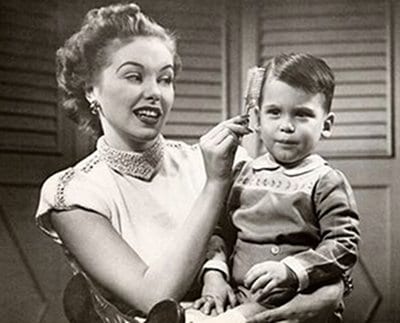
Married… divorced… separated… never together… what does any relationship status have to do with a man's parental duty? Once you’re a father, you're always a father. There is no you in the formula of life anymore. There is always at least one other person standing beside you in that equation. Always. Own that. And never leave that behind.
ReplyDeletefinancial help for single fathers
Jazzie, the term dead-beat Dad comes to mind when I read your comment.
ReplyDeleteAs a Dad who was married for 13 years to his kids Mom and then continued with both financial support and regular involvement in their lives, I agree with your comments. Today, with my kids in their 20's and starting families of their own, I know that they will take responsibility for their kids.
I did find it interesting to read the numbers that came about as a result of other factors besides marital relationships.